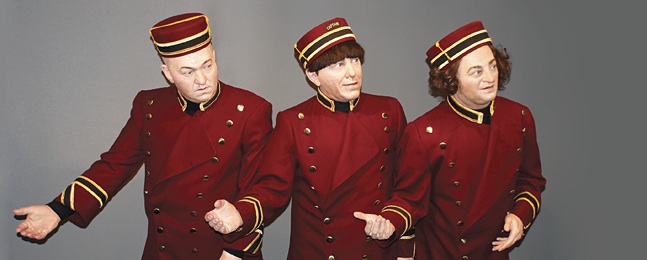King of the Stooges
Gary Lassin ’77 keeps alive the legacy of the lovable losers at his Stoogeum.

Courtesy Gary Lassin
by Davie E. Nathan
What’s a 55-year-old man doing operating the Stoogeum, the only museum dedicated to preserving the memory of the Three Stooges?
Having the time of his life, soitenly!
Gary Lassin ’77 is the founder, owner, director, benefactor, curator and publicist of the 10,000-square-foot Stooges shrine, which pays homage to the eye-poking, prank-pulling clown princes of slapstick whose short black-and-white film clips entertained Lassin and his buddies after school in the ’60s and ’70s.
Tucked away in an office park near Lassin’s suburban Philadelphia home, the 7-year-old Stoogeum features an 85-seat theater, memorabilia ranging from Moe’s comb to Stooge lunchboxes, touch-screen bios (poke the eye to get started), rare photos, and replicas of everyone’s favorite “numbskulls.”
The Stoogeum, which was featured recently in The New York Times and The Washington Post, attracts some 3,000 visitors a year. It opens once or twice a month and admission is free.
“I had two overriding goals in creating the Stoogeum,” Lassin says. “One, if the Stooges were still alive, would they be proud? Two, is this a place where a real Stooges fan would want his ashes scattered?”
The Stooges aren’t talking — the last one died in 1993 — and no one has yet brought in an urn, but Lassin has discovered other ways to gauge the success of his creation.
“When people walk out of the theater and leave the building, they’re always smiling and laughing,” the semiretired businessman says. “To the extent that I’ve taken them for a couple of hours and helped divert them from their problems and educate them about the Stooges, I’ve done my job.”
Lassin’s childhood fascination with the Stooges (Moe and Larry were the constants; Curly, Shemp, Joe and Curly Joe each spent time as the third Stooge) grew into a full-fledged obsession in 1979 after he met his wife-to-be, Robin. Her grandfather, Morris Feinberg, was the brother of Larry, the curly-topped Stooge. Larry had died four years earlier, but Lassin grew close to Feinberg.
“He had two daughters and five granddaughters, and none of them was interested in his Stooges stuff or the Stooges. Women typically aren’t fans,” Lassin says. “When I came along, I was the grandson he never had and he was the grandfather I never had.”
Starting with Morris’ small collection of memorabilia, Lassin became consumed with the idea of building the world’s largest treasure trove of Stooges memorabilia. Today, his collection contains 100,000 pieces, only 4,000 of which he has the space to display at the Stoogeum. After Morris died in 1986, Lassin also took over as president of the Stooges fan club.
“I sort of felt I was on a mission to preserve the family legacy, but that sense of mission was combined with my megalomanic desire to have the most stuff,” Lassin explains. “I wanted to be the ‘King of the Stooges.’ I always wanted to be the king of something, and I found what I could be the king of.”
To build his collection, Lassin attended Stooges conventions, subscribed to collectibles magazines, sought out dealers and befriended relatives of the other Stooges. Since the advent of the online auction site eBay and growth of his status as the Stooges collector of record, obtaining pieces is easier — but not nearly as much fun.
“In the old days, I had to outwork people and be persistent,” Lassin recalls. “I’d call a friend who had a friend who maybe had something. Now everyone calls me, because they know I’ll make a nice home for the piece and I won’t turn around and resell it.”
When it comes to stocking the museum, Lassin doesn’t distinguish between a Stooges caricature by well-known artist Al Hirschfeld (if you’re wondering, it contains three hidden “Ninas”), life-size wax statues (above) and an unused ticket from a live 1960s show. His rule: If it’s in good condition and authentic, the Stoogeum wants it.
“I collect as if I were the Stooges’ mother — anything that mentions my boys is fair game for the collection,” he says.
Lassin recognizes that his path is different from that followed by other members of Brandeis’ Class of 1977.
“I know my fellow Brandeisians have gone on to do great medical research and conquer Wall Street,” Lassin says. “Not everybody has the same calling. Not everybody is meant to go into brain surgery or find a cure for cancer or be a great political leader. I think I’ve found my niche.”
